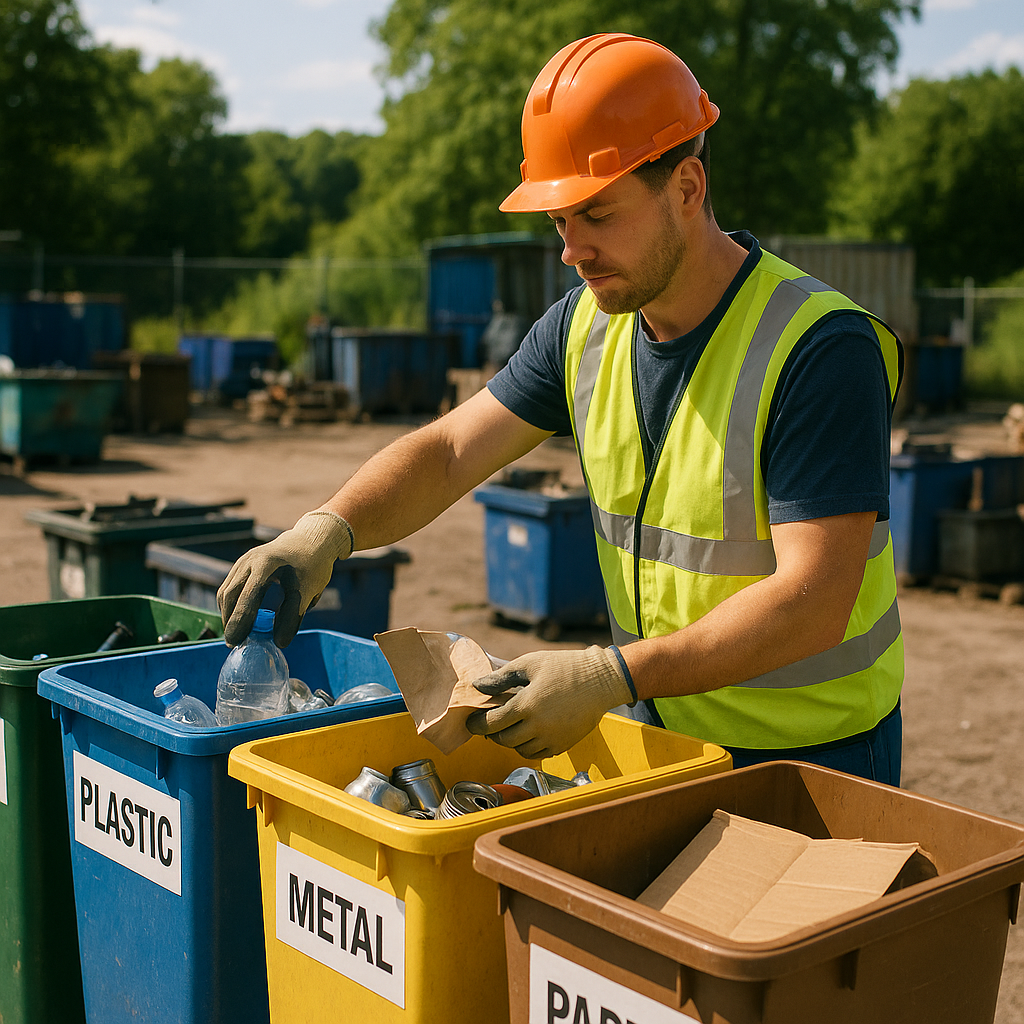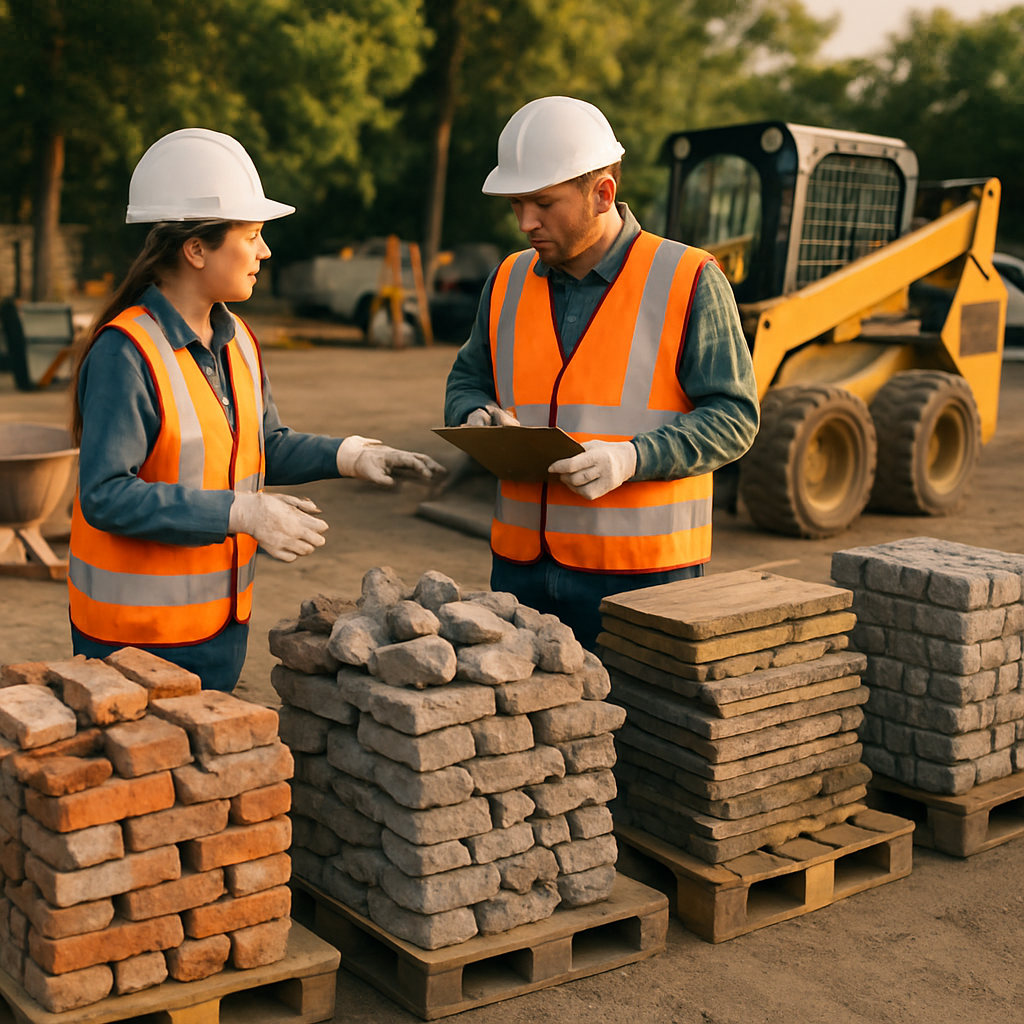5901 Botham Jean Blvd, Dallas, TX 75215
What is Demolition Waste Management for Office Buildings?
July 9, 2025Each year, demolition activities across the United States generate over 500 million tons of waste, accounting for approximately 40% of the country’s total solid waste output. For office buildings, demolition creates a complex stream of materials requiring systematic management.
Demolition waste management for office buildings involves a coordinated process of handling, sorting, and repurposing materials generated when commercial structures are dismantled. This systematic approach starts with thorough pre-demolition planning and continues through material segregation, processing, and ultimately recycling or reuse.
The process isn’t merely about disposal. Modern demolition waste management emphasizes resource recovery and circular economy principles. With effective minimization methods and waste segregation strategies, construction and demolition professionals can recover between 80-90% of materials that would otherwise end up in landfills. This approach not only protects the environment but also offers significant cost savings for building owners and contractors.
How to Create an Effective Waste Management Plan?

Creating an effective waste management plan requires thorough preparation and a systematic approach. A well-designed plan helps construction projects minimize environmental impact while saving costs through efficient resource management. Here’s how to develop your waste management strategy.
Conduct a Comprehensive Waste Audit
Start with a waste audit to understand your current waste streams. This initial step provides the data foundation for your entire plan.
Collect all waste from designated areas over a timeframe that represents normal operations. Weigh materials separately and document the types and quantities of waste generated. Look for patterns and identify which materials appear most frequently in your waste stream.
During your audit, calculate your current waste diversion rate by dividing the weight of recyclables by the combined weight of all waste, then multiply by 100 to get the percentage. This establishes your baseline for measuring improvements.
Set Clear, Measurable Goals
With audit data in hand, establish specific waste reduction objectives. Your goals should be SMART: Specific, Measurable, Achievable, Relevant, and Time-bound.
Common targets include reducing landfill waste by a specific percentage, increasing recycling rates, or reaching certain diversion thresholds. For example, you might aim to “Reduce landfill waste by 30% within 6 months” or “Achieve a 70% recycling rate for all paper products.”
Document these objectives and share them with all stakeholders to create accountability and emphasize the importance of the waste management plan.
Assign Roles and Responsibilities
Successful waste management requires clear ownership. Designate a recycling coordinator to oversee the implementation of your plan and ensure compliance.
Build a diverse team with representatives from different departments or trades to gain varying perspectives on waste habits. Assign specific responsibilities such as monitoring sorting stations, tracking progress metrics, or coordinating with waste removal services.
Provide thorough training for team members on safety protocols, sorting guidelines, and data recording methods. Regular refresher sessions will help maintain awareness and commitment to waste reduction goals.
Develop On-Site Waste Segregation Systems
Create an efficient infrastructure for separating waste materials at the source. Establish well-marked, centralized recycling stations with clear signage showing which materials belong in each bin.
Position bins strategically in high-traffic areas and near waste generation points. Consider color-coding your containers to make proper sorting intuitive. Remove individual waste bins and replace them with centralized sorting stations to encourage proper waste segregation.
Provide training materials with visual guides to help workers identify recyclable materials and understand proper sorting procedures.
Implement Resource Efficiency Strategies
Look beyond waste handling to reduce generation at the source. Carefully plan material orders to minimize excess and prevent over-purchasing. Store materials properly to prevent damage and waste.
Work with suppliers to reduce packaging waste or establish take-back programs for packaging materials. Consider using rental equipment instead of purchasing for items used infrequently on the project.
Identify opportunities to reuse materials on-site before discarding them. For example, clean wood scraps might be repurposed for blocking or bracing in later construction phases.
[[artifact_table]] Waste Management Plan Implementation Timeline [[/artifact_table]]Establish Monitoring and Reporting Procedures
Create systems to track your waste management performance over time. Regular monitoring helps identify problems early and demonstrates progress toward goals.
Schedule periodic mini-audits to sample waste composition and volumes. These check-ins help identify any backsliding or new problem areas quickly. Use digital tools or simple spreadsheets to record data consistently.
Develop a reporting schedule to share progress with stakeholders, highlighting successes and addressing challenges. Visual representations like charts or graphs make this data more accessible and impactful.
Partner with Reputable Waste Service Providers
Select waste removal companies that align with your recycling and sustainability goals. Research their waste handling practices to ensure materials are properly processed after leaving your site.
Discuss specific needs with providers, including container sizes, pickup frequency, and material acceptance policies. Request documentation of proper disposal and recycling to maintain records for regulatory compliance.
Consider specialized vendors for particular waste streams like electronics, hazardous materials, or organic waste that requires special handling.
What Are Key Strategies for Maximizing Recycling?

On-site waste segregation is the foundation of effective demolition waste recycling from office buildings. By establishing clearly labeled containers for concrete, wood, metals, glass, and plastics, crews can prevent contamination that often makes materials unrecyclable. This simple yet critical step significantly increases the percentage of materials that can be diverted from landfills.
Strategic partnerships with specialized recycling facilities create a reliable pathway for processing construction and demolition waste. These facilities possess the equipment and expertise to handle unique materials like drywall, ceiling tiles, and complex composite materials. When selecting a recycling partner, consider their processing capabilities, certifications, and track record with similar projects.
Mobile recycling units offer an innovative approach to waste management by bringing processing directly to the construction site. These portable systems can crush concrete into reusable aggregate, shred wood for mulch or biomass fuel, and process other materials on demand. This approach eliminates transportation costs while yielding immediately usable recycled products.
Advanced sorting technologies have improved recycling efficiency. Optical sorting systems use sensors and cameras to identify and separate materials based on visual properties. Magnetic separation quickly extracts ferrous metals from mixed debris streams. Air classification separates lightweight materials like paper and plastics from heavier items. These technologies enable processing of previously challenging mixed waste.
Deconstruction, instead of traditional demolition, preserves the integrity of valuable building materials. This careful dismantling process allows for recovering high-value components like hardwood flooring, architectural fixtures, and structural elements. While more time-consuming than conventional demolition, deconstruction significantly increases the quantity and quality of salvageable materials.
Material reuse is the highest form of recycling. Concrete can be crushed for road base or drainage applications. Untreated wood becomes mulch or biomass fuel. Metals are melted down for new products. Brick and masonry can be cleaned and reincorporated into new buildings. This approach closes the resource loop and reduces demand for virgin materials.
Comprehensive waste tracking provides accountability and identifies improvement opportunities. Documenting the types and quantities of materials recycled creates transparency and helps measure progress toward diversion goals. Many successful projects achieve recycling rates exceeding 90% through rigorous tracking and continuous improvement of waste management practices.
Implementing a detailed waste management plan before demolition begins ensures everyone understands roles and expectations. This plan should set specific diversion targets, outline sorting procedures, identify recycling partners, and address logistics like container placement and collection schedules. With proper planning, even challenging demolition projects can achieve impressive recycling outcomes.
[[artifact_table]] Construction Material Recycling Methods and Applications [[/artifact_table]]What Are the Benefits of Effective Demolition Waste Recycling?
Environmental Benefits
Recycling demolition waste from office buildings provides significant environmental advantages by considerably reducing the volume of debris in landfills. The EPA reports that construction and demolition projects generate 230 to 600 million tons of waste annually in the United States alone.
This practice conserves valuable natural resources by reusing materials that would otherwise require new extraction. Recycling concrete avoids the intensive energy processes needed to produce cement, while metal recycling saves energy and minimizes the mining impacts associated with raw ore extraction.
Another key benefit is the reduction of carbon emissions. Studies show that recycling construction and demolition debris can prevent approximately 6.41 kg of CO2 equivalent emissions per ton of processed material. This contributes directly to combating climate change and preserving natural landscapes that would otherwise be mined for virgin materials.
Economic Advantages
The financial benefits of demolition waste recycling are compelling for project stakeholders. Disposal costs decrease significantly when materials are diverted from landfills. Many municipalities require special permits for disposing of materials like concrete, creating additional expenses that recycling helps avoid.
Revenue generation is another economic benefit. Salvaged materials such as metals, wood, and certain fixtures can be sold to recycling facilities or directly to other construction projects, providing a secondary income stream that offsets project costs.
Project efficiency improves when recycling is integrated into demolition planning. With proper sorting systems, sites remain cleaner and more organized, streamlining the overall demolition process and potentially reducing project timelines.
[[artifact_table]] Cost savings comparison between traditional disposal and recycling of demolition waste materials [[/artifact_table]]Social Impact
The social benefits of demolition waste recycling extend beyond the project site. The recycling sector creates jobs throughout the supply chain, from on-site sorting specialists to processing facility workers who transform materials for reuse.
Public health improves through reduced pollution. Recycling demolition materials instead of landfilling or incinerating them results in fewer pollutants entering the air, soil, and water systems. This is particularly important in urban areas where demolition projects often occur near residential communities.
Sustainable development goals align perfectly with demolition waste recycling practices. By incorporating recycling into building demolition, companies demonstrate corporate social responsibility, a sustainability focus that increasingly influences hiring decisions, contractor selection, and brand reputation in the construction industry.
Conclusion: Implementing Successful Demolition Waste Recycling Plans

Implementing successful demolition waste recycling plans for office buildings requires a strategic and comprehensive approach. The process begins with conducting thorough waste audits to understand material composition. This knowledge forms the foundation for setting realistic diversion goals and creating tailored recycling strategies. Success also relies on effective waste segregation at the source, preserving material quality and maximizing recycling potential.
The best demolition waste management plans incorporate a balance of on-site and off-site processing strategies. They utilize advanced recycling technologies while maintaining clear communication and continuous training for all project stakeholders. The economic and environmental benefits are significant, including reduced disposal costs, lower carbon footprints, and conservation of valuable resources. For your next office demolition project, contact Okon Recycling at 214-717-4083 for expert guidance on implementing these sustainable waste management strategies.
